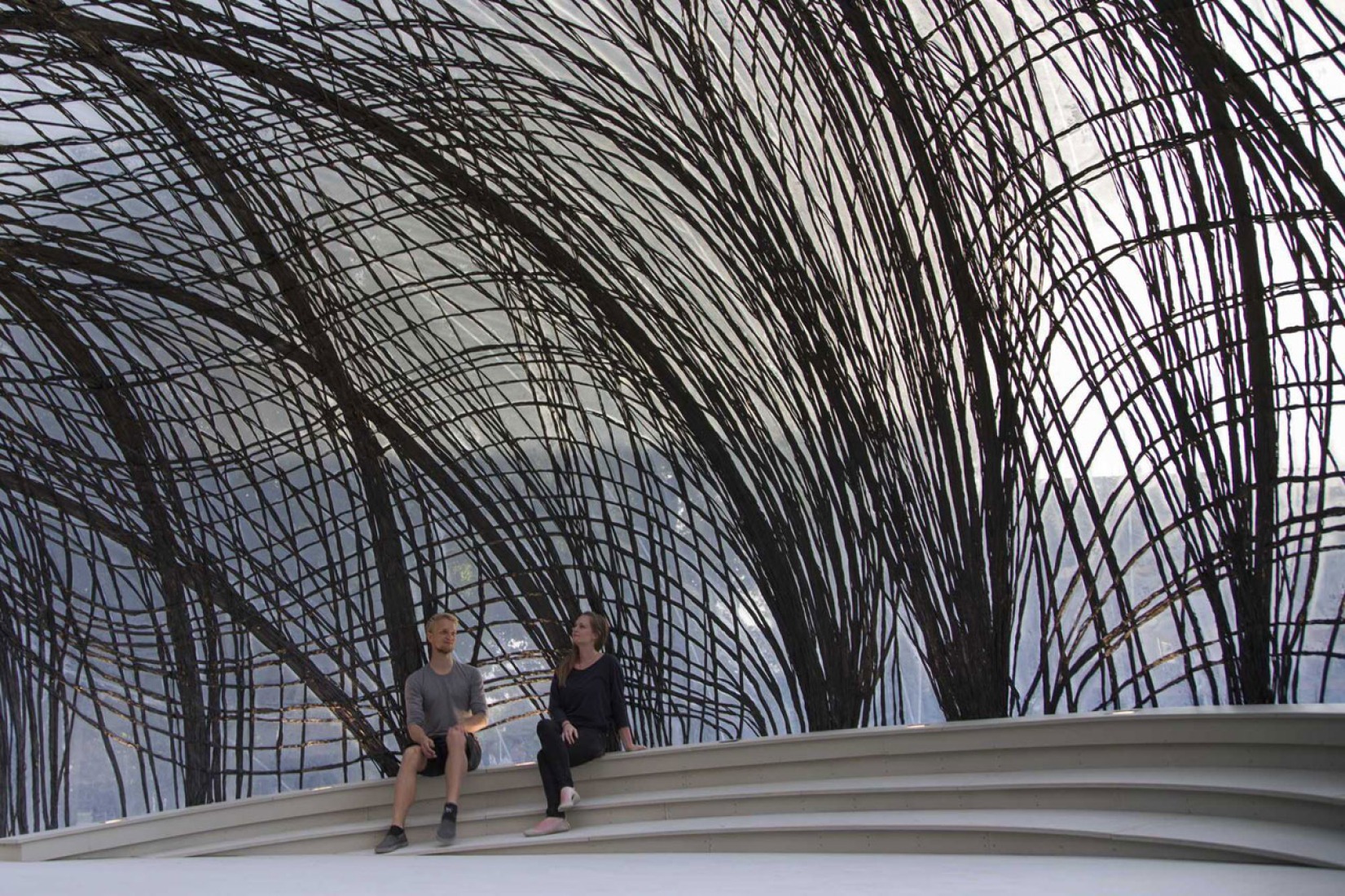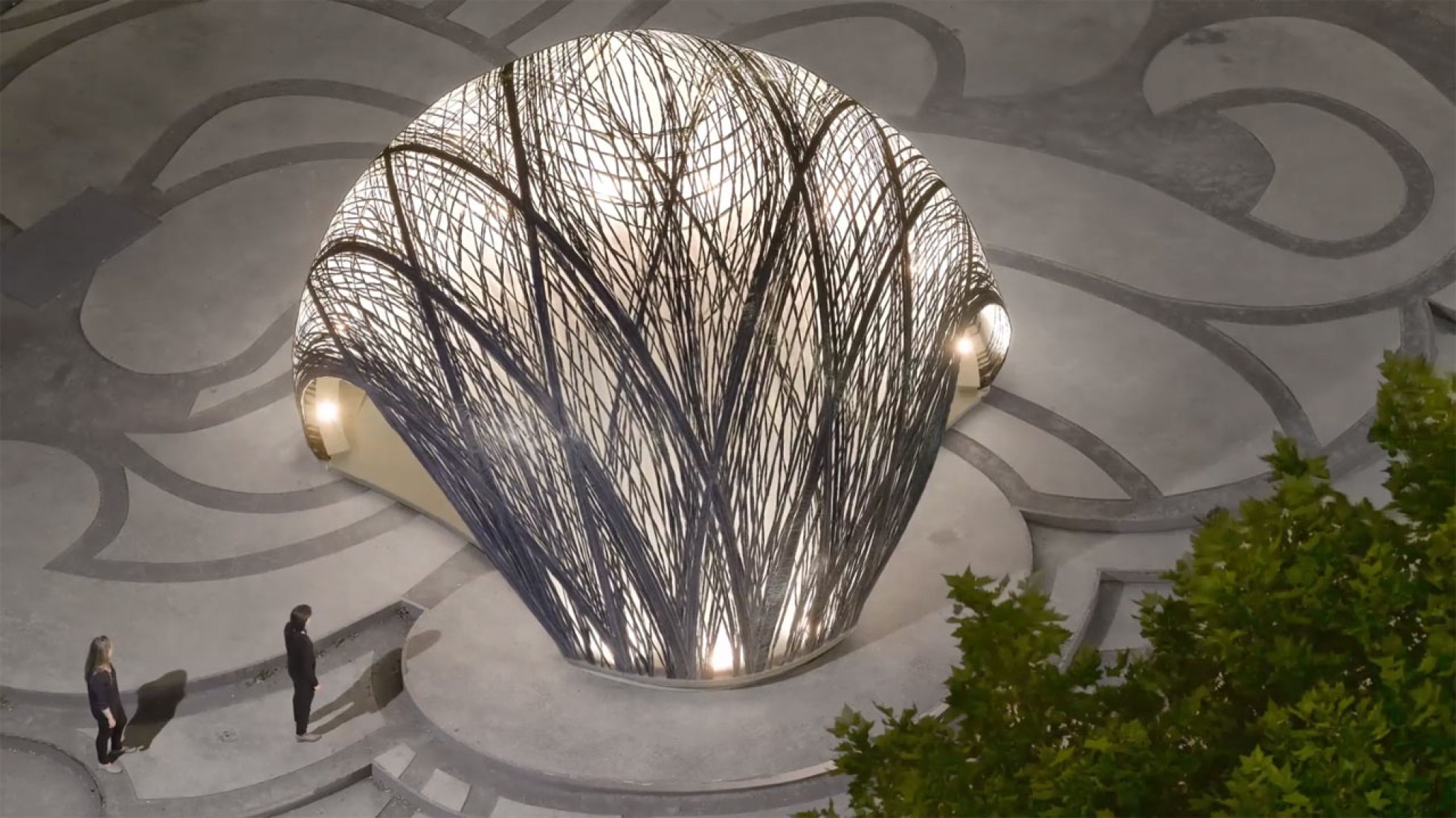The ICD/ITKE Research Pavilion 2014-15 demonstrates the architectural potential of a novel building method inspired by the underwater nest construction of the water spider. The resulting lightweight fiber composite shell forms a pavilion with unique architectural qualities, while at the same time being a highly material-efficient structure covering an area of about 40m² and an internal volume of approximately 130m³ with a span of 7.5m and a height of 4.1m. The total construction weight is just 260kg, which corresponds to a weight of 6.5kg / m².
Description of the project by Institute for Computational Design (ICD)
The design concept is based on the study of biological construction processes for fiber-reinforced structures. These processes are relevant for applications in architecture, as they do not require complex formwork and are capable of adapting to the varying demands of the individual constructions. The biological processes form customized fiber-reinforced structures in a highly material-effective and functionally integrated way. In this respect the web building process of the diving bell water spider, (Agyroneda Aquatica) proved to be of particular interest. Thus the web construction process of water spiders was examined and the underlying behavioral patterns and design rules were analyzed, abstracted and transferred into a technological fabrication process.
For the transfer of this biological formation sequence into a building construction application, a process was developed in which an industrial robot is placed within an air supported membrane envelope made of ETFE. This inflated soft shell is initially supported by air pressure, though, by robotically reinforcing the inside with carbon fiber, it is gradually stiffened into a self-supporting monocoque structure. The carbon fibers are only selectively applied where they are required for structural reinforcement, and the pneumatic formwork is simultaneously used as a functionally integrated building skin. This results in a resource efficient construction process.
At the beginning of the design and construction process, the shell geometry and main fiber bundle locations are generated by a computational form finding method, which integrates fabrication constraints and structural simulation. In order to determine and adjust the fiber layouts a computational agent-based design method has been developed. Similar to the spider, a digital agent navigates the surface shell geometry generating a proposed robot path for the fiber placement. The agent behavior is derived from a variety of interrelated design parameters. This computational design process enables the designer to navigate and simultaneously integrate these design parameters into various performative fiber orientations and densities.
During production nine pre-impregnated carbon fiber rovings are placed in parallel. 45km of carbon roving were laid at an average speed of 0.6 m min on 5km of robot path. This additive process not only allows stress-oriented placement of the fiber composite material, but it also minimizes the construction waste associated with typically subtractive construction processes. The ICD / ITKE Research Pavilion 2014-15 covers an area of about 40m² and an internal volume of approximately 130m³ with a span of 7.5m and a height of 4.1m. The total construction weight is just 260kg, which corresponds to a weight of 6.5kg / m².
Text.- Institute for Computational Design (ICD)
CREDITS.-
Project managers.- ICD Institute for Computational Design (Prof. Achim Menges). ITKE Institute of Building Structures and Structural Design (Prof. Jan Knippers).
Scientific Development.- Moritz Dörstelmann, Valentin Koslowski, Marshall Prado, Gundula Schieber, Lauren Vasey.
System Development, Fabrication & Construction.- WS13/14, SoSe14, WS14/15: Hassan Abbasi, Yassmin Al-Khasawneh, Yuliya Baranovskaya, Marta Besalu, Giulio Brugnaro, Elena Chiridnik, Tobias Grun, Mark Hageman, Matthias Helmreich, Julian Höll, Jessica Jorge, Yohei Kanzaki, Shim Karmin, Georgi Kazlachev, Vangel Kukov, David Leon, Kantaro Makanae, Amanda Moore, Paul Poinet, Emily Scoones, Djordje Stanojevic, Andrei Stoiculescu, Kenryo Takahashi and Maria Yablonina. WS14/15: Rebecca Jaroszewski, Yavar Khonsari, Ondrej Kyjanek, Alberto Lago, Kuan-Ting Lai, Luigi Olivieri, Guiseppe Pultrone, Annie Scherer, Raquel Silva, Shota Tsikoliya.
With the support of.- Ehsan Baharlou, Benjamin Felbrich, Manfred Hammer, Axel Körner, Anja Mader, Michael Preisack, Seiichi Suzuki, Michael Tondera
In collaboration with.- Departement of Evolutionary Biology of Invertebrates, University of Tuebingen
(Prof. Dr.Oliver Betz). Departement of Palaeontology of Invertebrates, University of Tuebingen
(Prof. Dr.James Nebelsick, Dr.Christoph Allgaier). Institute for Machine Tools, University of Stuttgart
(Dr. Thomas Stehle, Rolf Bauer, Michael Reichersdörfer). Institute of Aircraft Design, University of Stuttgart (Stefan Carosella, Prof. Dr.-Ing. Peter Middendorf).
Funding.- KUKA Roboter GmbH, GettyLab, tat aiRstructures, SGL Carbon SE, Sika Deutschland GmbH, Daimler AG, Walther Spritz- und Lackiersysteme GmbH, Lange+Ritter GmbH, Gibbons Fan Products Ltd, igus® GmbH, Peri GmbH, HERZOG Maschinenfabrik GmbH & Co. KG, AFBW – Allianz Faserbasierter Werkstoffe Baden-Württemberg e.V., Reinhausen Plasma GmbH, Reka Klebetechnik GmbH, HECO-Schrauben GmbH & Co. KG, Airtech Europe S.A., Mack Gerüsttechnik GmbH, RentES, Stahlbau Wendeler GmbH + Co. KG, CARU Containers GmbH, EmmeShop Electronics, STILL GmbH, SH-Elektrotechnik, GEMCO, Zeppelin Rental GmbH & Co. KG.





















































